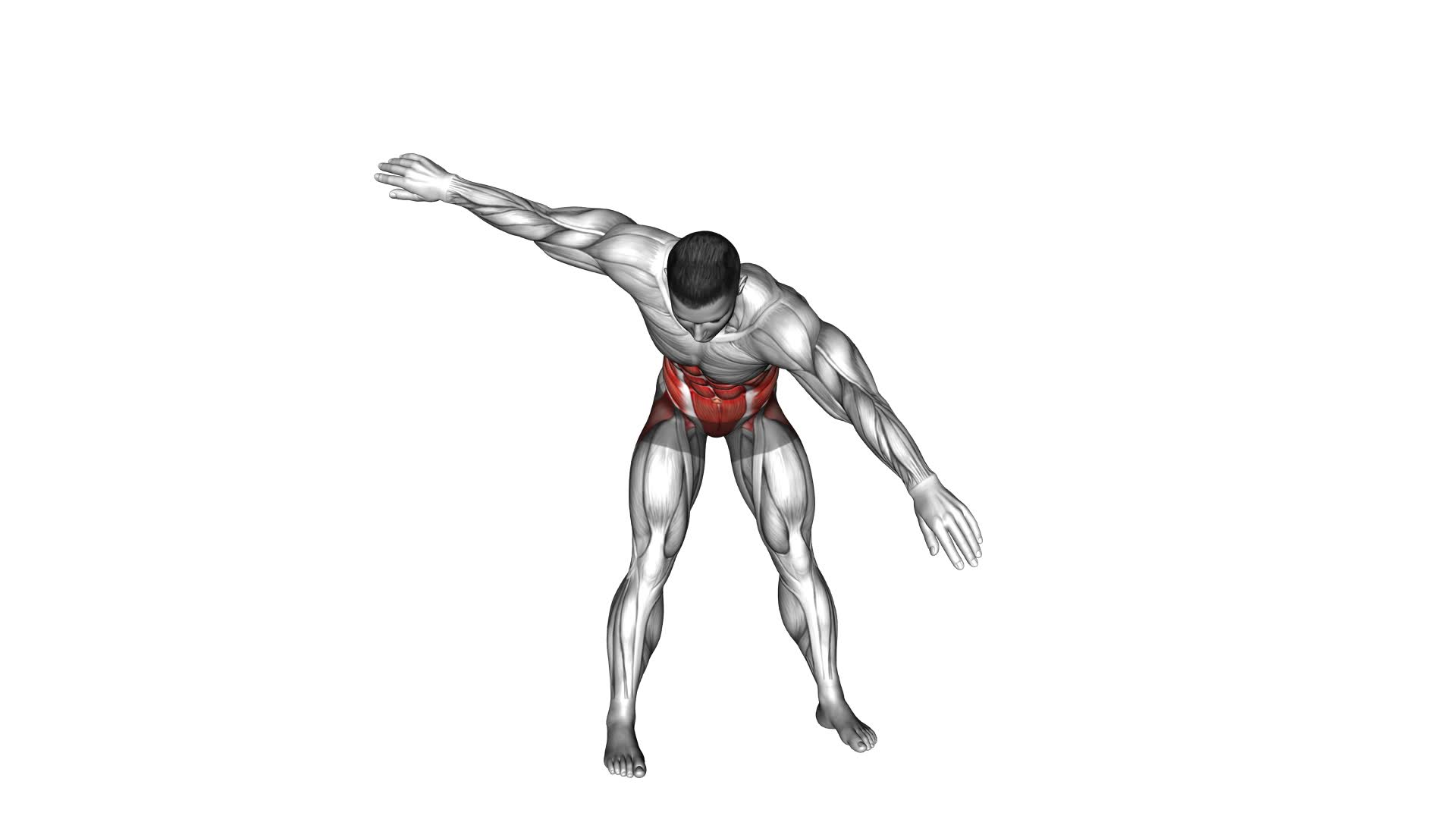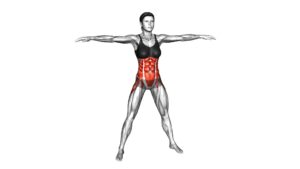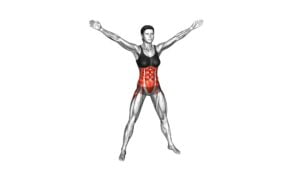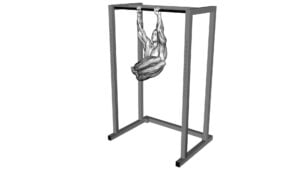Bodyweight Windmill – Video Exercise Guide & Tips

Get ready to amp up your workout routine with the bodyweight windmill! This exercise targets your core, shoulders, and hips, providing a full-body challenge.
Watch This Exercise Video
In this video exercise guide, you'll learn the proper form and technique, along with helpful tips and modifications. Whether you're a beginner or advanced, the bodyweight windmill is a great addition to any fitness regimen.
So grab a mat, press play, and get ready to feel the burn!
Key Takeaways
- The bodyweight windmill improves flexibility, core strength, shoulder mobility, and stability.
- Proper form and technique include keeping feet hip-width apart, engaging core muscles, maintaining straight arm overhead, and controlling the movement.
- Common mistakes to avoid include improper alignment, lack of core engagement, rushing the movement, and neglecting shoulder stability.
- Modifications for different fitness levels include adjusting the range of motion, adding resistance, and adjusting the pace of the exercise.
Benefits of the Bodyweight Windmill
Discover the numerous benefits you can experience by incorporating the bodyweight windmill exercise into your fitness routine.
This exercise is highly effective in improving flexibility and core strength. By performing the bodyweight windmill regularly, you can increase your flexibility levels as it requires a wide range of motion in the hips and shoulders.
This exercise engages your core muscles, including the abs, obliques, and lower back, which helps to strengthen and stabilize your midsection. As you rotate your body and reach for the ground, you activate the muscles in your core, leading to improved core strength over time.
Additionally, the bodyweight windmill exercise helps to enhance shoulder mobility and stability, making it beneficial for athletes and individuals who engage in activities that require upper body strength.
Incorporating this exercise into your fitness routine will also contribute to better posture and body alignment.
Proper Form and Technique for the Bodyweight Windmill
To ensure proper form and technique for the bodyweight windmill, focus on maintaining a strong core and controlled movement throughout the exercise. Here are some key tips to help you perform the bodyweight windmill correctly:
- Keep your feet hip-width apart: This will provide a stable base and help you maintain balance throughout the movement.
- Engage your core: Your core muscles, including your abs and obliques, play a crucial role in stabilizing your body during the windmill. Keep them activated throughout the exercise.
- Maintain a straight arm overhead: As you lower your body, make sure to keep your arm straight and in line with your shoulder. This will help you maintain proper alignment and prevent strain on your shoulder joint.
- Control the movement: Avoid rushing through the windmill. Instead, focus on moving slowly and with control. This will engage your muscles more effectively and reduce the risk of injury.
Common misconceptions about the bodyweight windmill include the idea that you need to touch the ground with your hand or that you need to twist your body excessively. Remember, the goal is to maintain proper form and control throughout the movement.
Now that you understand the proper form and technique for the bodyweight windmill, let's explore some modifications and progressions to help you challenge yourself and continue to improve your strength and flexibility.
Modifications and Progressions for the Bodyweight Windmill
Now that you understand how to properly perform the bodyweight windmill, how can you modify and progress this exercise to challenge yourself and continue improving? There are several modifications and progressions you can incorporate into your bodyweight windmill routine to make it more challenging and to target different muscle groups.
One modification you can try is adding weight to the exercise. Holding a dumbbell or kettlebell in your free hand as you perform the windmill will increase the resistance and make your muscles work harder. You can start with a light weight and gradually increase as you get stronger.
Another modification is to perform the windmill on an unstable surface, such as a BOSU ball or a foam pad. This will engage your core muscles even more as they work to stabilize your body during the movement.
To progress the bodyweight windmill, you can increase the range of motion by lowering your torso closer to the ground. This will require more flexibility and strength in your hips and hamstrings.
Incorporating these modifications and progressions into your bodyweight windmill routine will help you continue challenging yourself and improving your overall strength and flexibility.
Now that you know how to modify and progress the bodyweight windmill, let's move on to discussing common mistakes to avoid during the exercise.
Common Mistakes to Avoid During the Bodyweight Windmill
As you continue to perform the bodyweight windmill, it's important to be aware of common mistakes to avoid during the exercise. To ensure you're getting the most out of this movement and reducing the risk of injury, pay attention to the following:
- Improper Alignment: One of the most common mistakes isn't maintaining proper alignment throughout the movement. Make sure to keep your feet hip-width apart, shoulders stacked over your hips, and your spine in a neutral position.
- Lack of Core Engagement: The bodyweight windmill is a core-focused exercise, so it's crucial to engage your core muscles throughout the entire movement. This means keeping your abs and glutes tight to maintain stability and control.
- Rushing the Movement: Take your time with each repetition and focus on the quality of your movement rather than the quantity. Moving too quickly can compromise your form and increase the risk of injury.
- Neglecting the Shoulder Stability: The windmill involves a rotation of the shoulder joint, so it's important to maintain stability in this area. Avoid letting your shoulder collapse or rotate forward during the movement.
By avoiding these common mistakes, you can perform the bodyweight windmill effectively and safely.
Now, let's move on to the next section where we'll discuss tips for incorporating the bodyweight windmill into your workout routine.
Tips for Incorporating the Bodyweight Windmill Into Your Workout Routine
Once you have mastered the correct form and avoided common mistakes, it's time to incorporate the bodyweight windmill into your workout routine for an effective core-strengthening exercise. There are a few variations you can try to challenge yourself and target different muscle groups.
One variation is to perform the bodyweight windmill with a kettlebell or dumbbell in your top hand, adding resistance to your core and shoulders. Another variation is to perform the exercise on an unstable surface, such as a Bosu ball or balance board, which will engage your stabilizer muscles even more.
To incorporate the bodyweight windmill into your workout routine, you can start by performing 3 sets of 8-10 repetitions on each side. Make sure to maintain proper form throughout the exercise and take breaks between sets if needed. You can also include the bodyweight windmill as part of a circuit training workout, alternating it with other core exercises such as planks or Russian twists.
Remember to listen to your body and adjust the intensity and duration of your workout as needed. By incorporating the bodyweight windmill into your routine, you won't only strengthen your core muscles but also improve your overall stability and mobility. It's a versatile exercise that can be modified to suit your fitness level and goals.
Frequently Asked Questions
How Many Calories Does the Bodyweight Windmill Exercise Burn?
The bodyweight windmill exercise is a great way to burn calories and strengthen your core. By incorporating this exercise into your routine, you can expect to see results in terms of calorie burn.
The bodyweight windmill can be modified to suit your fitness level and goals, making it a versatile exercise. Not only does it help with calorie burn, but it also offers the benefits of bodyweight exercises, such as improved balance and flexibility.
Can the Bodyweight Windmill Help Improve Flexibility?
The bodyweight windmill is a great exercise for improving flexibility. By incorporating this exercise into your routine, you can enhance your range of motion and increase your overall flexibility.
The twisting and reaching movements involved in the windmill engage your muscles and stretch them, promoting flexibility in your hips, shoulders, and spine.
Additionally, this exercise can also help improve your balance, core strength, and stability.
Are There Any Specific Breathing Techniques to Follow During the Bodyweight Windmill?
During the bodyweight windmill, it's important to focus on your breathing. By following specific breathing techniques, you can enhance the effectiveness of the exercise.
These techniques involve inhaling deeply as you reach your arm towards the sky, and exhaling as you rotate your torso and lower your hand towards the opposite foot. This coordinated breathing pattern helps engage your core muscles and maintain stability throughout the movement.
Additionally, modifications can be made for individuals with lower back pain to ensure proper form and prevent discomfort.
Can the Bodyweight Windmill Be Performed by Individuals With Lower Back Pain?
If you have lower back pain, there are alternative exercises you can do instead of the bodyweight windmill. It's important to prioritize your safety and avoid aggravating your condition.
However, if you still want to try the bodyweight windmill, there are modifications available to help reduce the strain on your lower back.
Consult with a fitness professional or physical therapist to determine the best approach for your specific situation.
How Long Does It Take to See Results From Incorporating the Bodyweight Windmill Into Your Workout Routine?
Incorporating the bodyweight windmill into your workout routine can yield noticeable results within a few weeks.
The benefits of the bodyweight windmill include improved core strength, flexibility, and stability.
By performing variations of the bodyweight windmill, such as adding weights or increasing the range of motion, you can enhance the effectiveness of the exercise and see even faster results.
Consistency and proper form are key to achieving the desired outcomes.
Conclusion
Incorporating the bodyweight windmill into your workout routine can provide numerous benefits. This exercise is great for improving core strength, flexibility, and stability. By following proper form and technique, you can maximize the effectiveness of this exercise. It's important to start with modifications and progressions that suit your fitness level. Rushing through the movement is a common mistake that should be avoided. Take your time and focus on maintaining proper form throughout the exercise. With these tips in mind, you can confidently add the bodyweight windmill to your fitness regimen.

Author
Years ago, the spark of my life’s passion ignited in my mind the moment I stepped into the local gym for the first time. The inaugural bead of perspiration, the initial endeavor, the very first surge of endorphins, and a sense of pride that washed over me post-workout marked the beginning of my deep-seated interest in strength sports, fitness, and sports nutrition. This very curiosity blossomed rapidly into a profound fascination, propelling me to earn a Master’s degree in Physical Education from the Academy of Physical Education in Krakow, followed by a Sports Manager diploma from the Jagiellonian University. My journey of growth led me to gain more specialized qualifications, such as being a certified personal trainer with a focus on sports dietetics, a lifeguard, and an instructor for wellness and corrective gymnastics. Theoretical knowledge paired seamlessly with practical experience, reinforcing my belief that the transformation of individuals under my guidance was also a reflection of my personal growth. This belief holds true even today. Each day, I strive to push the boundaries and explore new realms. These realms gently elevate me to greater heights. The unique combination of passion for my field and the continuous quest for growth fuels my drive to break new ground.







